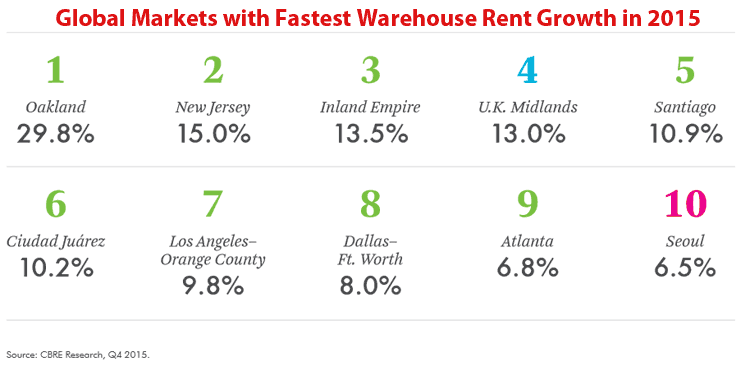How did rates for renting distribution space fare in 2015?
We're just catching up with the report on global real estate from the pros at CBRE Research that was released in late May.
Supply Chain Digest Says... |
 |
| ecommerce order fulfillment is driving demand for urban warehouse space across the globe, as shippers look to enable rapid local deliveries |
 |
What do you say? |
| Click here to send us your comments |
 |
| Click here to see reader feedback |
|
|
"Despite a tumultuous global economic climate in 2015, prime logistics rents in global hub markets increased 2.8% year-over- year amid growing demand, driven principally by the growth of global supply chains and the expansion of consumption and production into new locations," the study notes.
Of the 68 global logistics hubs evaluated in the report, 59% (40 markets) recorded an annual increase in prime rents, 25% (17 markets) experienced no change and only 16% (11 markets) saw decreases.
Not surprisingly, the most expensive markets for warehouse space globally are in metro regions that are "land constrained," where geography obviously limits supply. At the far end of the curve on that variable is Hong Kong, where average annual rates at the end of 2015 (based on exchange rates at that time) were a whopping $28.94 per square foot per year, far above number 2 Tokyo at $16.74.
The full top 10 is as follows:
1. Hong Kong: $28.94
2. Tokyo: $16.74
3. London: $16.36
4. Singapore: $10.91
5. Stockholm: $9.90
6. Shanghai: $9.44
7. Manchester/Liverpool: $8.75
8. Leeds/Sheffield: $8.45
9. Sydney: $8.34
10. Shenzhen: $8.27
With land generally much more available in the US, no metro area in the country made the top 10, though a couple were close, as noted later in this article.
But that wasn't the case in terms of fastest growth in warehouse rentals last year. Here, six metro areas made the top 10, led by the incredible rise of almost 30% in Oakland, as shown in the graphic below.

Why such rapid growth in Oakland? The report doesn't really explain, but our guess would be shippers are moving to Oakland from other more expensive locales of the Bay area, in what was seen as a not very desirable location not long ago. With that surge, rents in Oakland rose to $7.32, putting it now third in the US behind LA/Orange county ($8.04 and in 12th place globally) and Houston ($7.59 and 17th globally).
Of course, rate changes were different regionally across the globe. In the Americas, prime logistics rents increased 5.6% during 2015, largely due to massive growth in U.S. coastal markets, where strong occupier demand drove up pricing, CRBE says.
Prime rents for space in logistics facilities in Asia Pacific rose by 2.5% over the past year, with Seoul and Auckland recording growth rates of more than 5%, driven by robust demand from ecommerce and third-party logistics firms.
(See More Below)
|
CATEGORY SPONSOR: SOFTEON |
|
|
| |
|
|
But a still weak economy in most of Europe slowed rent growth there, with rates up just 0.8% year over year.
Of course, ecommerce order fulfillment is driving demand for urban warehouse space across the globe, as shippers look to enable rapid local deliveries, generally supplementing "big box" DCs outside the city core with smaller local facilities that stock the most popular SKUs, generally replenished by the big box facilities nearby.
The Primary Warehouse Space Trends
CRBE identified three key trends in the market for warehouse space globally:
1. Prime rent levels are resilient despite the recent economic headwinds, with prime industrial rents at the same or higher level from year-end 2014 in 85% of the tracked markets, and the global average up 2.8% year-over-year.
2. Land-constrained markets command a significant rent premium over other markets. Most of the hubs on the most expensive list are markets where available land for industrial development is limited and expensive. Markets where land is more plentiful, most notably major US hubs like Chicago, Dallas-Ft. Worth and Atlanta, are far more affordable.
3. There is new development taking place to meet the rising demand for prime space. However, this likely won't alleviate rent pressures, as these facilities will remain in high demand thanks to the secular shift in ecommerce and trade. In other words, occupiers in most parts of the world should expect these trends to persist for a while - and plan accordingly
CRBE also found that in the fourth quarter of 2015, construction of 44.7 million square feet of new industrial space (mostly warehouses) in the US was completed, with an additional 183 million square feet under construction.
"Speculative development has become prevalent and represents the majority of new development in most core markets in the US. This, coupled with falling availability and strong leasing demand, has pushed sustained national rent growth," CRBE says.
The full report can be found here: Global Prime Logistics Rents
Anything surprise you in the CRBE data? What trends are you seeing in terms of warehouse space costs? Let us know your thoughts at the Feedback section below.
Your Comments/Feedback
|